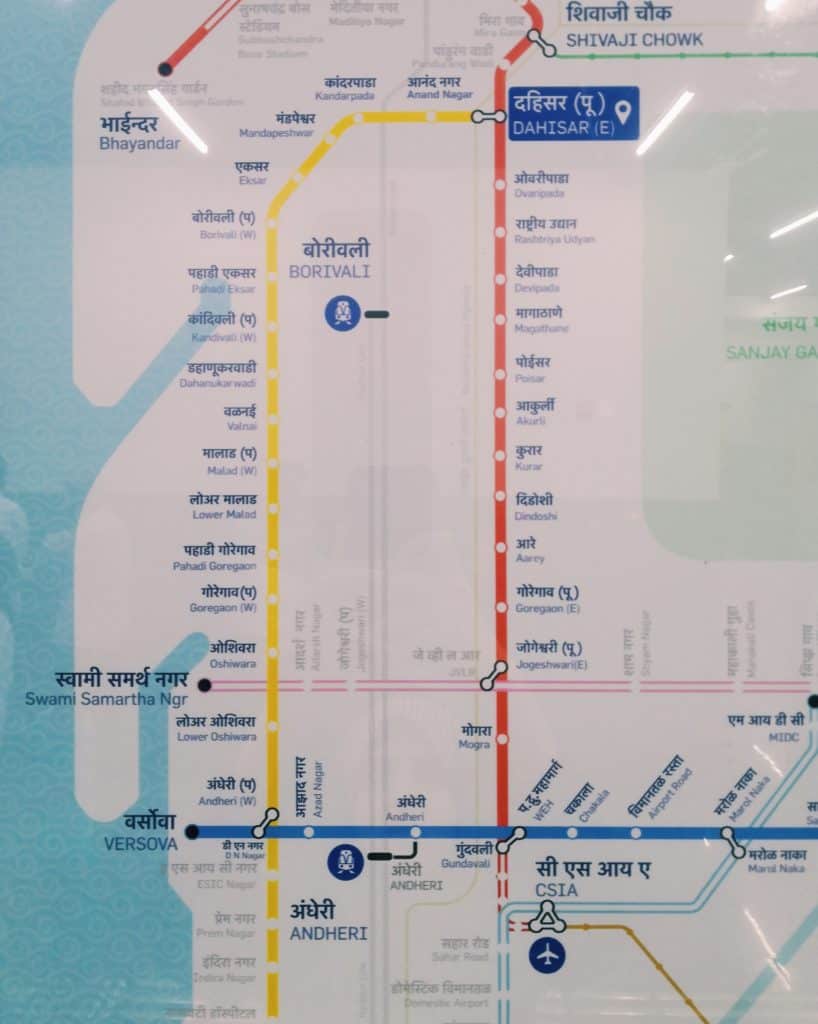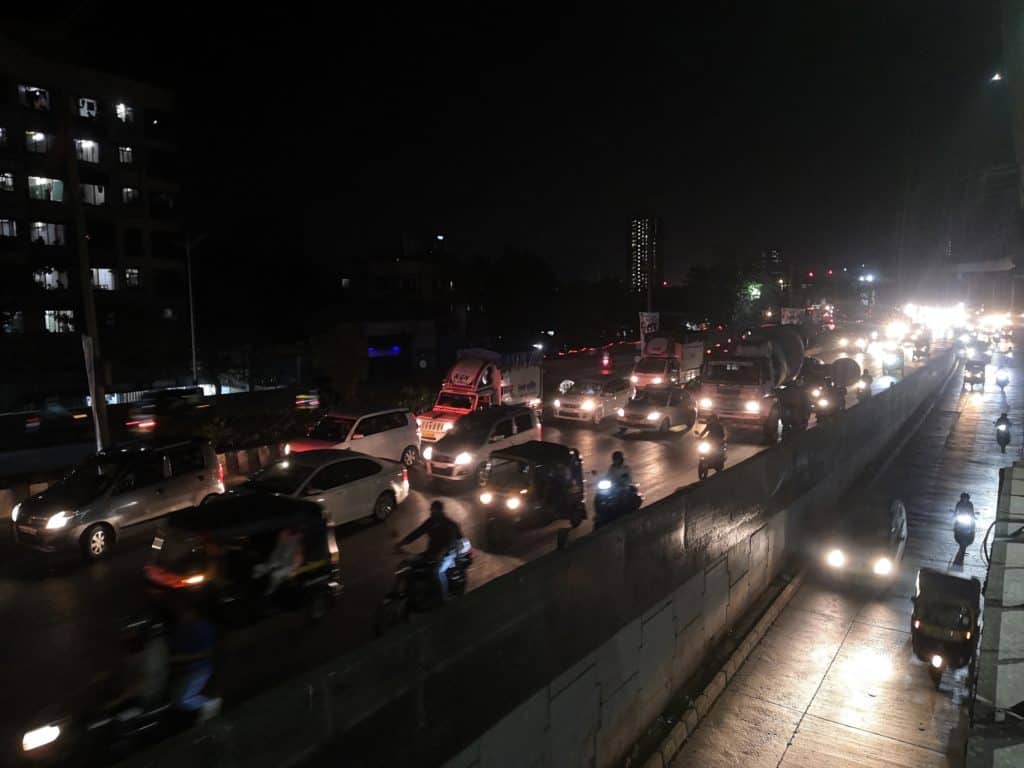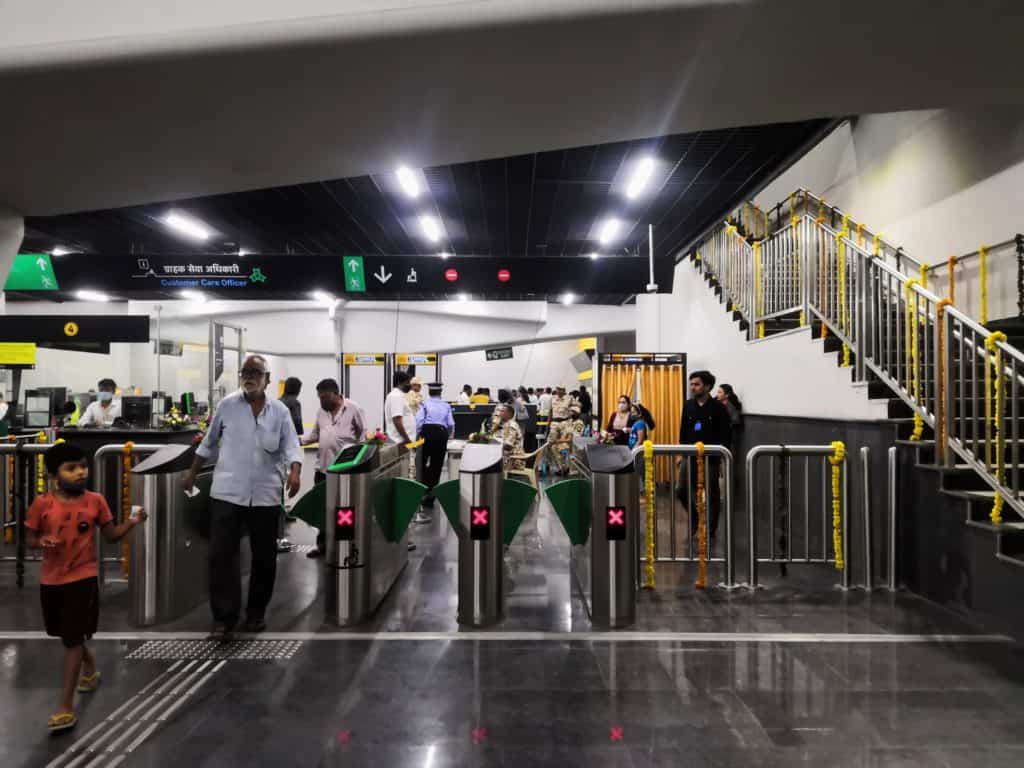April 2nd was a big day for Mumbai. After 8 long years, the blue line of Mumbai’s metro was getting 2 new additions: the yellow Line 2A and red Line 7.
On the shared Dahisar metro station, Line 2A left to Dahanukarwadi, Kandivali. Parallely, the metro on Line 7 left for Aarey in Goregaon, covering the extent of Phase 1. With the upcoming Phase 2, the 18.5 km and 16.5 km long lines will travel 30 stations bewteen them, connecting DN Nagar, Andheri West and Andheri East on the older Line 1.
The lines are a clear rival for the heavily congested Western Express Highway, running alongside it in the east and west-side of the suburbs. “This patch on the highway takes 30-45 minutes in car, but now it will take barely 10,” says Pearl, a Dahisar resident who plans to use the metro regularly when she starts a new job in June.
Line 2A expects to have a ridership of 6.09 lakh daily by 2031, along with being additionally extended by Line 2B to Mandale, 24 km in the east of the city. Line 7 expects to carry 6.68 lakh people every day and will also be a part of an extensive red line, connecting Mira Bhayandar to the CSIA Terminal 2.
For now, Mumbai’s metro has been bumped to 30 km long, up from 8 years of covering only 11 km. This is expected to change dramatically in the current decade. If the Mumbai Metropolitan Region Development Authority (MMRDA) plans come to fruition, Mumbai’s metro will be 337 km long by 2030.
To understand the project and its implications, Citizen Matters spoke to SVR Srinivas, the metropolitan commissioner of the MMRDA and managing director of the Mumbai Metro Rail Corporation (MMRC).
What remains to be completed of Line 2A and 7?
Phase 1, which covers 20 km and 18 stations, is fully operational. We’re trying to open Phase 2 in the next 5-6 months.
Different types of work remain, involving the stations, tracks, electrification, signalling, telecommunications, some civil work, software issues and integration. It’s a very complex project. This is the first time the MMRDA has completed and commissioned a project of this size, and it will decongest the Western suburbs big time.

The MMRDA website lists the expected ridership of the lines in 2031 together at 12 lakh per day. Who is the target demographic – car, bus or train users?
We are expecting to shift people from cars, auto rickshaws, intermediary public transport and to some extent, city buses. The buses will no longer run parallel to the metro, but as a feeder to the metro.
We also expect some shifts from suburban railways commuters, especially on Line 2A. But for that, completion of Phase 2 is very important. It will connect the new lines to the Metro Line 1 at Andheri and DN Nagar, so integration will be better than what we’re seeing now.
There’s also been a push towards integrating non-motorised transport (NMT) in the network, especially with the rent-a-bike stations at the stations. Do you expect them to play a significant role?
We are encouraging cycle stands at all the stations, and we’ve also made provisions for carrying cycles in the metro. Especially for people in and around BKC, there will be a service road for people to cycle from Andheri (when it’s connected by Phase 2). That will reduce pollution, shift them from the main road and make it more motorable.
The future of urbanism lies partially in NMT, and it is the need of the hour. Peoples’ adaptation depends upon their comfort level and the time they save. We have to provide the appropriate conditions. For cycles, this generally means a clear and direct road or a cycle track, and a mechanism for keeping cycles at stations. This we can also outsource to a cycle providing agency. People will then shift to NMT, if not fully then partially.

Will the metro reduce the traffic on the roads, such as the Western Express Highway (WEH), and to what extent?
Once the new metro lines are connected to Line 1, which stretches across Versova-Andheri-Ghatkopar, the 2 north-south lines will form a complete loop with the east-west line. We are expecting about 20% of the traffic on the WEH to shift when this happens. Line 2 and 3 will reduce more of the traffic on Linking road, where a lot of congestion occurs.
What are the measures taken to increase first and last-mile connectivity to other public transport systems from the metro? Are there new feeder bus routes?
First-mile connectivity connects commuters from home to the metro. There, auto rickshaws (in the suburbs), city buses and non motorised transport (NMT) play a role. But last mile connectivity, between the station and workplace, is equally important. City buses also play a big role here. We’ve coordinated with the local city bus and they are re-routing their bus routes for this purpose.
We’ve also ensured multimodal integration, so buses can stop at appropriate positions not too far away from the stations for people to get on and off seamlessly.
The Metro Line 1 – running from Versova to Ghatkopar – does not meet its expected ridership, even before the pandemic. It has been rivalled by the BEST buses, decreasing its footfall when BEST slashed its fee. Why so, and is there a danger that pattern will repeat with the new lines?
The Metro Line 1 follows the same route as the Andheri-Ghatkopar Link road, and even then we’d asked BEST to reorganise their bus routes as a feeder service. Otherwise, it would be a losing proposition for BEST.
Line 1 is quite successful. It covers 11 km and had a ridership of 4-4.5 lakh. Delhi, in comparison, has only 2 million riders for 150-200 km. But the ridership of Line 1 came down during COVID-19 because a lot of things changed. We don’t know if the changes are permanent or temporary, and how long they’ll last. Mumbai is already recovering, so it definately won’t be bad for long. If proper connectivity and service is given, ridership will be good.
Read more: Interview: “People buy cars in Mumbai because they don’t have to think of parking cost”
Some commentators have raised the worry that because of the relatively high ticket price (compared to the trains), the metro risks becoming semi-elite. Do you share these concerns, and have any steps been taken to appeal to lower-income groups?
Affordability is not an issue. On Line 2A and 7, 3 km costs Rs 10. 20 km will cost Rs 40-50. An auto rickshaw, which is an ordinary non-AC transport, takes more than that. The rate itself is very low, and we’re actively considering concessions for some people, which we will announce later.
The metro and bus should be seen together as a holistic network, in which both will benefit if they augment each other. For that, there needs to be a reorientation of the local bus routes. We’re constantly in touch and they’re already doing it.
In a previous interview, you mention the need for changes in the Development Control Regulations, which are the rules that control development in a city according to a planned process. Transit oriented development (TOD) would, as you said, encourage growth in population and work opportunities around transit stations. What are the changes needed?
Whenever we bring in new transit lines, the area along the corridor develops. The benefits of the development goes to the local developers. But the government needs money to invest in projects and the metro, so the idea is to plough back those revenues, even if it is only 5-10%, back to MMRDA.
Building a metro is expensive and its operational efficiencies are huge. Any city worth its salt has a proper metro, but for that you need resources for it, and land is a very good resource.
We’re expecting stamp duty concessions to be given wherever there are metro lines. We’re also requesting the government to approve transit oriented development (TOD), so part of the additional benefits the local developers enjoy will go to the government to be used for the metro. If a flat worth Rs 1 crore appreciates in value to Rs 1.2 crore, we’ll only be asking for Rs 50,000, a very small amount of the total.

With the 337 km of metro lines planned by 2030, is Mumbai on its way to becoming a metro-centric city?
The plan is to make a transit-oriented city. In the last 15 years, the share of public transport in Mumbai has gone down to almost 9-10% of the total. This is a very dangerous sign, because the share should always increase. To address this, it is necessary to have a transit and metro systems. It is possible Mumbai may become a metro-oriented city in the process.
What is the next metro line on the horizon, and when should Mumbaikars expect it to start?
Line 6, which is stretched across the east-west axis along JVLR, will take about 2-3 years. We also want to complete Line 4, connecting south Mumbai to Thane, in the next 3 years. The other major metro line is the underground Line 3 between Colaba and Seepz, and will be completed within 2 to 2 and a half years.
In 3-4 years, Mumbai will be well connected in all directions. People will be able to enjoy good, comfortable and safe journeys. Mumbaikars have a very good time to look forward to.